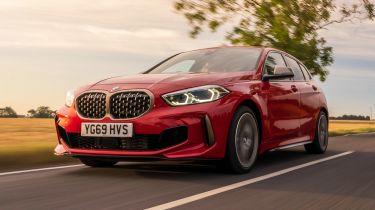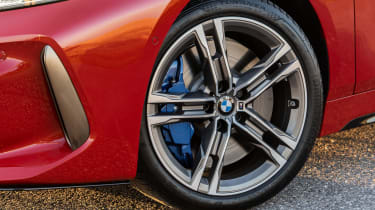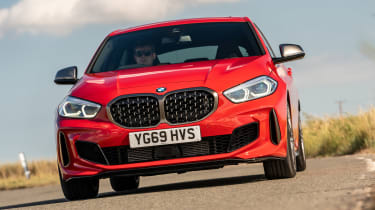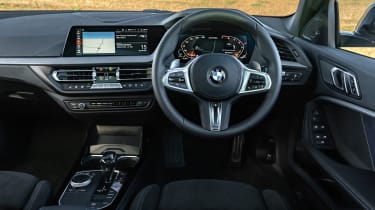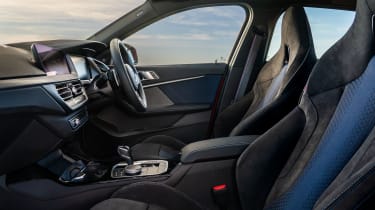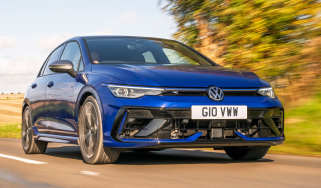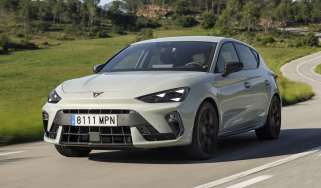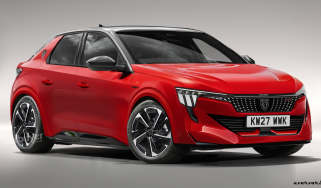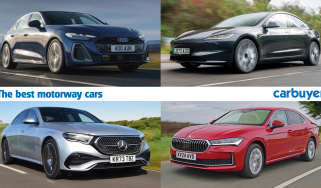BMW M135i review – a fast and practical hot hatch, but lacks character
“The latest BMW M135i is undoubtedly fast, and a recent update has added some of the old car’s character”
Pros
- Fantastic interior
- Performance
- Improved practicality
Cons
- Lacks character
- Rear headroom tight
- Rivals are cheaper
Verdict – is the BMW M135i a good car?
The BMW M135i set off to a shaky start when it was first introduced – sure, it boasted impressive performance, but it lacked the excitement you expect of a hot hatch. Revisions in 2022 have largely improved this, so it’s more characterful than before, but some will continue to lament the loss of the old car’s sonorous 3.0-litre engine. Still, the BMW M135i boasts a beautiful interior, is still undoubtedly fast, and is more practical than the older M140i.
BMW M135i models, specs and alternatives
The BMW M135i is a hot hatchback that sits right at the top of the 1 Series range as its most powerful flagship version. Despite being the brand’s smallest car, the BMW M135i boasts punchy power figures and a clever xDrive all-wheel drive system.
While the old M140i was powered by a large 3.0-litre straight six, the current M135i uses a 2.0-litre turbocharged engine. While it’s slightly less powerful than that of the M140i, its 302bhp is still a substantial power output, and propels the M135i from 0-62mph in just 4.8 seconds. That’s actually a quicker sprint time than the M140i can manage, and the xDrive four-wheel drive system means it feels more reassuring and planted to the road as well.
 The UK's top 10 fastest hot hatchbacks 2025
The UK's top 10 fastest hot hatchbacks 2025
One big problem with the current BMW M135i when it first launched, was that it lacked excitement, even with its impressive power output and fancy technology. Thankfully BMW realised this fairly early on, and the M135i got a host of updates even before it was due for a mid-life facelift, reinjecting some of that hot-hatch X factor.
More reviews
Car trim reviews
In-depth reviews
Road tests
Used car reviews
As of spring 2022, the M135i’s suspension was recalibrated and it got new tyres, an improved soundtrack and software tweaks for the xDrive all-wheel-drive system, which have all added up to a much-improved driving experience. It’s worth noting that the majority of these changes are only applied to cars without the fancy adaptive dampers; cars with the trick suspension are much the same as before. BMW says the vast majority of buyers go without the upgraded dampers, which is why it’s made the changes to the standard model.
Now, the M135i is much closer to the Mercedes-AMG A 35 or the slower Honda Civic Type R when it comes to driving fun. If you want something a little different, take a look at the cheaper front-wheel-drive BMW 128ti.
The M135i sits at the top of the BMW 1 Series range, so it’s quite well equipped. It gets the upgraded infotainment system, heated M Sport seats, sat-nav and exclusive styling tweaks, among other features. You do pay extra for the M135i compared to some rivals but we’d expect the difference to be relatively small in terms of the monthly payments on a PCP finance deal.
The widescreen infotainment system, coupled with a digital instrument cluster, premium materials and ambient lighting, means the interior is one of this car’s standout elements. It’s more spacious, too; the rear seats are much more accommodating than those of the previous car and the boot’s a bit bigger.
As good as the M135i is, it feels like there should be an even more extreme model above it in the range to rival the Audi RS3 and Mercedes-AMG A 45. The BMW M2 is more comparable to these hot hatches, but it’s not as practical as the M135i.
MPG, running costs & CO2
Fuel economy won’t be the main concern for anyone who buys an M135i, but you’ll get reasonable figures when you’re not exploiting the engine’s full potential. The downsized four-cylinder 2.0-litre engine is a little more economical than the 3.0-litre six-cylinder engine fitted in the old car, and you should be able to achieve up to 38.2mpg when driving carefully. Neither the Mercedes-AMG A 35 and Volkswagen Golf R will top 40mpg, either, and the M135i’s figure is slightly better than what you can expect from a Cupra Leon - although that car is also available as a more frugal plug-in hybrid.
A starting price just shy of £41,500 means the BMW M135i falls into the premium rate of VED (road tax). This means you’ll need to pay an additional £390 on top of the £180 standard rate from year two. It’s payable until the car is six years old, which means an M135i costs almost an extra £2,000 to tax.
With CO2 emissions starting from 168g/km, the M135i sits towards the top of the bandings for company-car tax. As with all BMWs, you get a three-year, unlimited-mileage warranty, and BMW offers a three-year service plan for £20 per month.
Engines, drive & performance
The previous car was the only rear-wheel-drive hot hatchback on sale, and as a result it stood out as a great choice for keen drivers. The new car has moved to BMW’s xDrive all-wheel-drive system, so it’s much more similar to the Audi RS3 and Volkswagen Golf R. In normal driving, the M135i is front-wheel drive to save fuel but becomes AWD as soon as more traction is required.
All-wheel drive means the M135i can be as fast as the previous BMW M140i, despite having a much smaller and less powerful engine. The 335bhp 3.0-litre six-cylinder engine has been replaced by a 2.0-litre four-cylinder engine pushing out 302bhp. The new model is still blisteringly rapid in a straight line, hitting 0-62mph in 4.8 seconds and maxing out at a limited 155mph. Launch control and a brilliant eight-speed automatic gearbox are fitted as standard.
Despite the performance of the M135i, it leaves you feeling a little cold. The smaller engine can’t match the great sound of the six-cylinder unit in the previous car, and the exhaust does little to enhance its noise. The experience ends up feeling rather ordinary and you feel a bit detached from the action. There’s always an impressive amount of grip, but less in the way of outright excitement. We can imagine there being some disappointed buyers if they’re coming from an M140i.
 The 10 best hot hatchbacks to buy in 2025
The 10 best hot hatchbacks to buy in 2025
It seems BMW has taken criticism of the M135i xDrive on board, as in 2022 it made changes to the car’s hardware and software. Some of the changes to the setup come from the less powerful 128ti version of the 1 Series, such as the revised suspension with new lower arms that make the car stiffer and more responsive.
The xDrive system has been updated so it now sends power to all four wheels more of the time, and BMW has even changed the car’s recommended tyres to more performance-focused rubber. The artificial engine noise has been made to sound more realistic, and it’s louder as well. All these changes show us what the M135i could’ve been like all along, because the updated car is far more entertaining to drive and feels like the hot hatch it is.
Interior & comfort
The interior will be instantly recognisable if you’ve been in any other BMW, but that’s no bad thing. Everything is aimed at the driver, and all the controls are placed so they’re easy to find and use. The quality of the materials used and the construction seem fantastic, although the Mercedes-AMG A 35 adds more theatre and is even more impressive.
You get M Sport heated front seats upholstered in a suede-like fabric, plus a 10.25-inch digital instrument cluster and the upgraded widescreen infotainment system. As it’s based on the M Sport trim, the M135i also features auto LED headlights, two-zone climate control and a sportier steering wheel.
BMW offers a number of packs and options, including an M135i Plus pack (19-inch alloys, sun protection glass and an upgraded stereo), a Tech Pack and a Comfort Pack. The latter adds a powered tailgate (for the first time on a 1 Series), a heated steering wheel and electric front seats. Other options include a panoramic sunroof, extra safety kit and sporty exterior add-ons. For 2022, the Sao Paulo Yellow paint option from the BMW M4 has been added to the colour palette, bringing a searingly vibrant choice alongside the greys, blacks and blues.
Practicality & boot space
BMW’s decision to make the BMW 1 Series front-wheel drive has liberated more space for passengers and luggage, and the all-wheel-drive M135i seems to offer just as much versatility as cheaper and less powerful models. Those in the front might not notice too much of a difference but rear-seat occupants enjoy more leg and elbow room than before. Headroom is a little tight in the back for six-footers, though.
Boot space is up 20 litres, so it now exactly matches the space you get in a Golf R or an Audi S3. Handily, the tailgate opening is now much wider and a more useful shape, and it’s easier to load boxy items into the M135i than the M235i saloon. BMW doesn’t recommend towing with the M135i - it’s the only 1 Series variant that doesn’t come with the option of a towbar.
Reliability & safety
Euro NCAP gave the BMW 1 Series a full five-star safety rating in 2019, and this score extends to the M135i too. Standard safety equipment includes autonomous emergency braking, pedestrian and cyclist detection and lane-departure warning, and you can add extras like a head-up display and cross-traffic warning to make the car even safer.
Reliability could be an issue because the BMW 1 Series finished a highly disappointing 72nd out of 75 cars in our Driver Power 2023 new car survey. Only the Range Rover Evoque, Citroen C3 Aircross and Vauxhall Mokka finished lower. Not a great performance for a premium hatchback.
Things were little better for the brand, with BMW languishing in 21st place out of 32 on the list of manufacturers. If we were writing a school report, we’d say there’s room for improvement.

